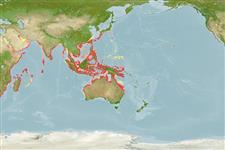Common names from other countries
>
Pleuronectiformes (Flatfishes) >
Cynoglossidae (Tonguefishes) > Cynoglossinae
Etymology: Paraplagusia: Greek, para = the side of + Greek, plagos, plagios = oblique.
More on author: Bloch.
Environment: milieu / climate zone / depth range / distribution range
Ecología
marino; salobre demersal; rango de profundidad 1 - 25 m (Ref. 30573). Tropical; 33°N - 32°S, 30°E - 154°E
Indo-Pacific: Red Sea and east coast of Africa to the Philippines, north to southern Japan, south to New Guinea and northeastern Australia.
Tamaño / Peso / Age
Maturity: Lm ? range ? - ? cm
Max length : 31.6 cm TL macho / no sexado; (Ref. 94837); common length : 25.0 cm TL macho / no sexado; (Ref. 30573)
Espinas dorsales (total): 0; Radios blandos dorsales (total): 99-115; Espinas anales 0; Radios blandos anales: 72 - 89; Vértebra: 50. Upper side tan, marbled with dark wavy lines enclosing pale patches; 2 lateral lines on eyed side, none on blind side (Ref. 4418). Caudal vertebrae 36-44; mid-lateral line scales 75-109 (Ref. 9224, 11691).
Found on mud and sand bottoms of the continental shelf (Ref. 30573). Enters shallow estuarine waters (Ref. 4833) and tidal rivers (Ref. 1479).
Life cycle and mating behavior
Madurez | Reproducción | Puesta | Huevos | Fecundidad | Larva
Masuda, H., K. Amaoka, C. Araga, T. Uyeno and T. Yoshino, 1984. The fishes of the Japanese Archipelago. Vol. 1. Tokai University Press, Tokyo, Japan. 437 p. (text). (Ref. 559)
IUCN Red List Status (Ref. 130435)
Warning: mysqli::__construct(): (HY000/1040): Too many connections in /var/www/html/includes/func_getlabel.php on line 46
Can't connect to MySQL database (fbapp). Errorcode: Too many connections
